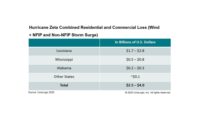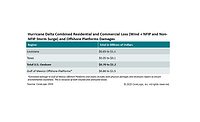$16 Billion to $24 Billion in Insured and Uninsured Flood Losses in the Northeast from Tropical Storm Ida, CoreLogic Estimates

CoreLogic, a leading global property information, analytics and data-enabled solutions provider, released additional loss estimates for Hurricane Ida, following its initial release estimating between $27 billion and $40 billion in insured and uninsured losses from wind, storm surge and inland flooding in Louisiana and Mississippi. According to this new analysis, specifically for the U.S. Northeast, subsequent Tropical Storm Ida caused an estimated $16 billion to $24 billion in insured and uninsured inland flood losses to residential and commercial properties.
“Given the prevalence of multifamily housing and below-ground structures in these areas, we’ll see more extreme interior content damages than we typically see in southern coastal areas,” said Shelly Yerkes, senior leader, insurance solutions at CoreLogic. “For example, many of the heating, ventilation and air conditioning systems in New York City buildings are in the basements, so contents damage should be substantial.”
Total insured flood loss for residential and commercial properties in the U.S. Northeast is estimated to be between $5 billion and $8 billion, while uninsured flood loss for this area is estimated to be between $11 billion and $16 billion. Pennsylvania, New Jersey, New York, Connecticut and Massachusetts sustained approximately 90% of the losses.
After Hurricane Ida made landfall in Port Fourchon, La. on August 26, it continued to travel northeast as it downgraded to a tropical storm status, bringing devastating rainfall of six-to-nine inches in three hours in New York, New Jersey and surrounding states. This record-setting precipitation caused a flash flood event as the rain overwhelmed storm water drainage systems in urban areas where the average monthly rainfall is approximately three inches and little green space exists to absorb sudden inundations of water. Tropical Storm Ida’s flood event affected a region nearby Superstorm Sandy’s impact area in 2012, which caused extensive storm surge-related flooding along the coastlines and shorelines of the East River and the Hudson River. Catastrophic weather events like these are becoming more common and local governments and property owners are taking note, making infrastructure and home resilience improvements in the wake of the recent storms.
“The flooding from Superstorm Sandy was more severe than Tropical Storm Ida,” said David Smith, senior leader of science and analytics at CoreLogic. “Due to the repairs made in 2012, such as strengthening buildings and infrastructure and addressing deferred maintenance, New York was less vulnerable. Tropical Storm Ida’s effects on New Yorkers would have been worse if we hadn’t conducted these resilience-based repairs after Superstorm Sandy.”
Analysis includes residential homes and commercial properties, including contents and business interruption and does not include broader economic loss from the storm.
Methodology
CoreLogic offers high-resolution location information solutions with a view of hazard and vulnerability consistent with the latest science for more realistic risk differentiation. The high-resolution flood modeling using 10m digital elevation model (DEM) and structure- and parcel-based geocoding precision from PxPoint™ facilitates this realistic view of risk, including both fluvial (riverine) and pluvial (surface) flooding. Single-family residential structures less than four stories, including mobile homes, duplexes, manufactured homes and cabins (among other non-traditional home types) are included in this analysis. Multifamily residences and commercial properties are also included.
Source: CoreLogic
Looking for a reprint of this article?
From high-res PDFs to custom plaques, order your copy today!





